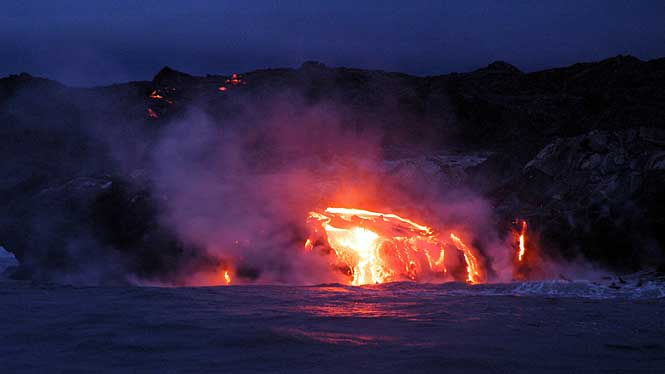Scientists love the Big Island because they can get an up-close and personal view of an active Hawaii lava flow.
Pele, Goddess of Fire
Legends say that the Big Island of Hawaii is the home of Pele, the Hawaiian goddess of fire. Using fiery lava, Pele shaped and formed her beloved islands. Ancient Hawaiians paid their respects to the goddess by presenting offerings to please her or placate her wrath.
Pele, perhaps, lives on in the form of Hawaii’s five volcanoes. One is extinct, another is dormant and the remaining three are categorized as active.
Hawaii Volcanoes
The oldest is Kohala Volcano, which is believed to have emerged from the sea more than 500,000 years ago. Over the centuries, lava flows from its two neighbors, the much larger Mauna Loa and Mauna Kea volcanoes, have buried a portion of Kohala. Today, Kohala is considered to be an extinct volcano.
Mauna Kea is the tallest of Hawaii’s volcanoes; in fact, standing at 13,796 feet, it is the world’s tallest mountain (measured from the floor of the ocean to its summit). Mauna Kea is considered a dormant volcano, having last erupted about 4,500 years ago.
Hualalai on the Big Island’s western side is the third-youngest of the island’s volcanoes. The 1700s, scientists say, were a period of significant volcanic activity for Hualalai, with six different vents spewing lava, two of which produced lava flows that reached the ocean. The Kona International Airport is built atop the larger of the two flows.

Mauna Loa
Extending from the Big Island’s northwest region near Waikoloa to the entire southwest and to the east near Hilo, Mauna Loa (“Long Mountain”) covers about half of the island. It is the world’s largest volcano. It’s also considered one of the most active volcanoes, having erupted 33 times since 1843. Its most recent eruption occurred in 1984. Scientists believe that Mauna Loa is certain to erupt again.
Kilauea
Finally, there is Kilauea, the world’s most active volcano. It has been spewing lava continuously since January 1983. Situated near the southeastern section of the Big Island, Kilauea was once considered a part of Mauna Loa. Subsequent research, however, showed that Kilauea has its own magma-plumbing system
Hawaii Volcanoes National Park, the Big Island’s top visitor attraction, offers a wealth of information about the island’s volcanoes. With over half the acreage designated as wilderness, the park provides great hiking and camping opportunities.
